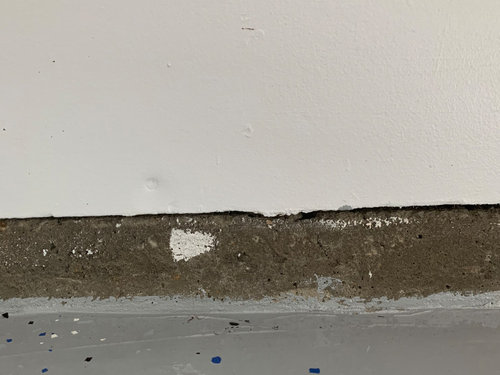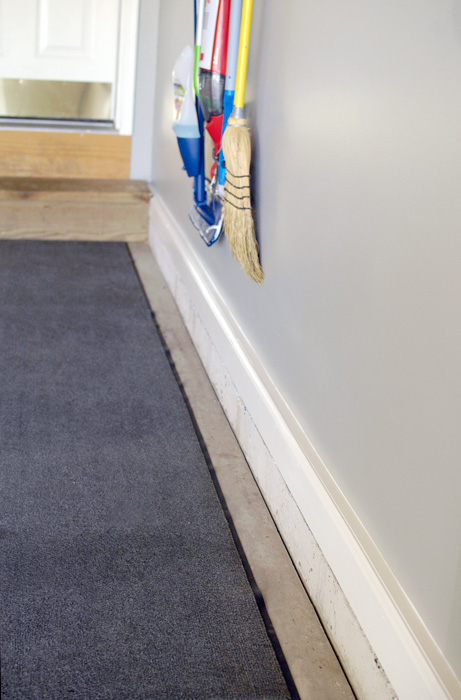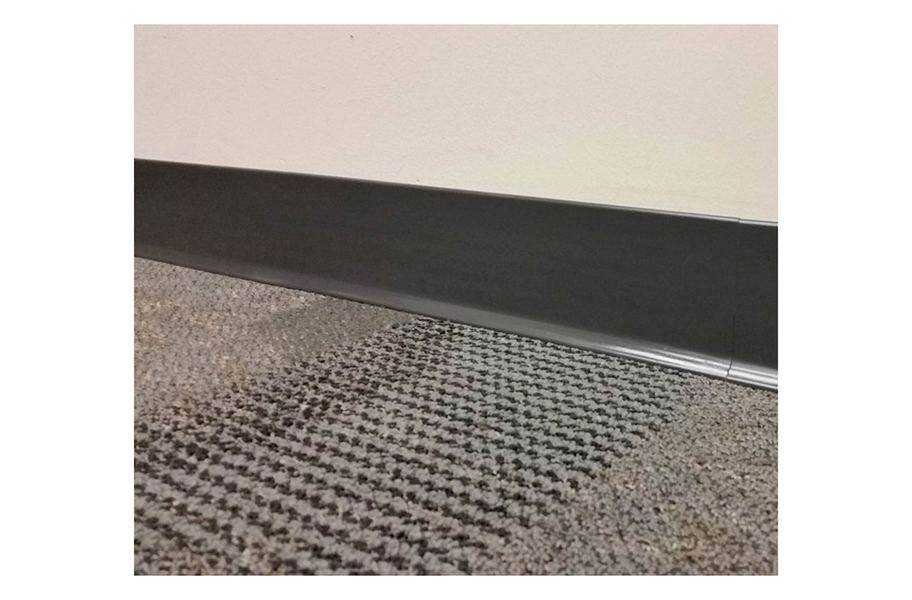Garage Floor Base Molding: Purpose and Benefits
Garage floor base molding is often an overlooked yet crucial component of garage maintenance and aesthetics. It serves multiple functions, from protecting the walls to enhancing the overall appearance of the space. Understanding the purpose and benefits of garage floor base molding can help homeowners make informed decisions about installing and maintaining this essential feature.
- Protection for Walls: One of the primary purposes of garage floor base molding is to protect the lower part of the walls from damage. Garages are high-traffic areas where vehicles, tools, and other equipment can cause scuffs, dents, and scratches on the walls. Base molding acts as a barrier, absorbing impacts and preventing unsightly marks and structural damage.
- Moisture Barrier: Garages are prone to moisture from various sources such as rain, snow, and general condensation. Base molding helps seal the gap between the floor and the wall, preventing water from seeping into the wall structure. This moisture barrier is crucial in preventing mold growth, wood rot, and other moisture-related issues that can compromise the integrity of the garage.
- Pest Prevention: A properly installed base molding can also act as a deterrent for pests. Small gaps and cracks between the garage floor and walls can serve as entry points for insects and rodents. Base molding seals these gaps, making it more difficult for pests to infiltrate the garage, thereby protecting stored items and maintaining a cleaner environment.
- Enhanced Aesthetic Appeal: Beyond its functional benefits, garage floor base molding also enhances the visual appeal of the garage. It provides a clean, finished look that can make the space appear more organized and professionally maintained. This can be particularly important for homeowners who use their garage as a workshop or a secondary living space.
- Easy Maintenance: Garage floor base molding makes it easier to keep the garage clean. It creates a smooth transition between the floor and the wall, which simplifies sweeping and mopping. Without molding, dirt and debris can accumulate in the gaps, making cleaning more challenging. The smooth surface of the molding also resists staining and can be easily wiped down.
- Value Addition: Installing garage floor base molding can add value to a home. Potential buyers often appreciate well-maintained and thoughtfully designed spaces. A garage with base molding can stand out as a more polished and functional area, which can be a selling point in real estate transactions.

Types of Garage Floor Base Molding Materials
When it comes to garage floor base molding, the choice of material is crucial for ensuring durability, functionality, and aesthetics. Various materials are available, each with its own set of characteristics, benefits, and drawbacks. Understanding the different types of garage floor base molding materials can help homeowners select the best option for their specific needs and preferences.
PVC (Polyvinyl Chloride) Base Molding
PVC is a popular choice for garage floor base molding due to its durability and resistance to moisture and chemicals. It is easy to clean and maintain, making it ideal for high-traffic areas like garages. PVC molding is available in various colors and styles, allowing homeowners to match it with their existing garage decor. Its flexibility also makes it easier to install around corners and irregular surfaces.
Rubber Base Molding
Rubber base molding is another excellent option, especially for garages used as workshops or hobby areas. Rubber is resilient and can withstand significant wear and tear. It provides a cushioned barrier that can protect both the walls and any equipment that might come into contact with them. Additionally, rubber molding is highly resistant to moisture and is easy to clean, making it a practical choice for garages exposed to harsh conditions.
Metal Base Molding
Metal base molding, typically made from aluminum or stainless steel, offers a sleek and industrial look. It is extremely durable and can withstand heavy impacts and harsh conditions. Metal molding is resistant to corrosion and can be a good option for garages exposed to the elements or used for heavy-duty purposes. However, it can be more challenging to install compared to other materials and may require professional assistance.
Wood Base Molding
For homeowners looking for a more traditional or rustic aesthetic, wood base molding can be an attractive choice. Wood provides a warm and natural look that can complement other wooden elements in the garage. However, it is less resistant to moisture and pests compared to other materials. To mitigate these issues, wood base molding should be properly sealed and maintained regularly.
Composite Base Molding
Composite base molding combines the benefits of multiple materials, such as wood fibers and plastic resins. This type of molding is designed to offer the aesthetic appeal of wood with the durability and moisture resistance of plastic. Composite molding is also less likely to warp or rot, making it a low-maintenance option suitable for various garage environments.
Foam Base Molding
Foam base molding, typically made from polystyrene or polyurethane, is lightweight and easy to install. It can be cut to fit various shapes and sizes, making it a versatile option for DIY enthusiasts. Foam molding is resistant to moisture and pests, but it is less durable compared to other materials and may not withstand heavy impacts. It is best suited for garages with minimal foot traffic and light usage.
Choosing the Right Base Molding for Your Garage
Selecting the appropriate base molding for your garage involves considering various factors such as durability, moisture resistance, aesthetic appeal, and ease of installation. Each garage has unique requirements based on its usage, climate conditions, and personal preferences. Here’s a comprehensive guide to help you choose the right base molding for your garage.
Assess Your Garage’s Needs
Start by evaluating how you use your garage. If it’s a high-traffic area with heavy equipment, you’ll need a durable material like PVC or metal. For garages that double as workshops or hobby spaces, rubber molding can provide added protection and cushioning. Understanding your specific needs will help narrow down the options.
Consider Moisture and Climate Conditions
The climate and moisture levels in your area are critical factors in choosing base molding. In regions with high humidity or heavy rainfall, moisture-resistant materials such as PVC, rubber, or composite molding are ideal. These materials prevent water damage and mold growth, ensuring the longevity of your base molding.
Evaluate Aesthetic Preferences
The appearance of the base molding can significantly impact the overall look of your garage. Choose a material that complements your garage’s style. For a sleek, modern look, metal or PVC molding in neutral colors can be suitable. If you prefer a traditional or rustic aesthetic, wood or composite molding with a wood-like finish can enhance the space’s visual appeal.
Budget Considerations
Cost is always a consideration when undertaking home improvement projects. PVC and foam molding are generally more affordable and easy to install, making them cost-effective choices for many homeowners. Metal and composite molding, while more expensive, offer superior durability and longevity. Balance your budget with your long-term needs to make a wise investment.
Ease of Installation
If you plan to install the base molding yourself, consider materials that are easy to work with. Foam and PVC molding are lightweight and can be cut and installed with basic tools, making them ideal for DIY projects. Metal and wood molding may require more specialized tools and expertise, potentially increasing the installation complexity and cost.
Maintenance Requirements
Different materials have varying maintenance needs. PVC and rubber molding are low-maintenance options that resist stains and can be easily cleaned with standard household cleaners. Wood molding, while aesthetically pleasing, requires regular sealing and maintenance to protect against moisture and pests. Choose a material that fits your willingness and ability to perform regular upkeep.
Step-by-Step Installation Guide for Garage Floor Base Molding
Installing garage floor base molding is a practical DIY project that can significantly enhance the functionality and appearance of your garage. With the right tools and materials, you can complete this task efficiently. This step-by-step guide will walk you through the process of installing base molding in your garage.
1. Gather Necessary Tools and Materials
Before starting the installation, ensure you have all the necessary tools and materials. You will need:
- Base molding of your choice
- Measuring tape
- Pencil
- Miter saw or utility knife
- Adhesive or nails (depending on the material)
- Caulk gun and caulk
- Cleaning supplies
Having everything ready will make the installation process smoother and more efficient.
2. Prepare the Garage Area
Clear the garage area where you plan to install the base molding. Remove any objects, debris, and dirt from the floor and walls. Cleaning the area thoroughly ensures that the molding adheres properly and looks neat once installed. Use a broom, vacuum, or damp cloth to clean the surfaces.
3. Measure and Cut the Base Molding
Measure the length of the walls where the base molding will be installed. Use a measuring tape and mark the lengths on the molding with a pencil. For precise cuts, use a miter saw for rigid materials like wood, metal, or composite. For softer materials like foam or rubber, a utility knife will suffice. Make sure to cut the molding at appropriate angles for corners to ensure a snug fit.
4. Apply Adhesive or Nail the Molding
Depending on the type of molding, you will either use adhesive or nails to attach it to the wall. For PVC, rubber, and foam molding, a strong construction adhesive applied with a caulk gun is typically sufficient. Apply a bead of adhesive along the back of the molding and press it firmly against the wall. For wood or metal molding, use finishing nails or screws to secure it in place.
5. Seal the Edges
Once the molding is attached, use caulk to seal any gaps between the molding and the wall or floor. This step is crucial for preventing moisture from seeping behind the molding. Apply a thin bead of caulk along the edges and smooth it out with your finger or a caulking tool for a clean finish. Allow the caulk to dry according to the manufacturer’s instructions.
6. Final Touches and Cleanup
After the caulk has dried, inspect the installation for any gaps or uneven areas and make necessary adjustments. Clean any excess adhesive or caulk from the surfaces. Finally, step back and admire your work. The newly installed base molding should provide a polished, professional look while offering protection and durability to your garage walls.
Maintaining and Cleaning Garage Floor Base Molding
Proper maintenance and cleaning of garage floor base molding are essential to ensure its longevity and functionality. Regular upkeep not only preserves the aesthetic appeal of the molding but also helps prevent damage caused by dirt, moisture, and wear and tear. Here’s a comprehensive guide on how to maintain and clean garage floor base molding effectively.
Regular Dusting and Sweeping
One of the simplest yet most effective ways to maintain garage floor base molding is through regular dusting and sweeping. Use a soft-bristle broom or a vacuum cleaner with a brush attachment to remove dust, dirt, and debris from the molding. This routine cleaning prevents the buildup of grime that can cause stains and scratches over time.
Washing with Mild Detergents
Periodically wash the base molding with mild detergent and water to remove any stubborn dirt or stains. Use a soft sponge or cloth to avoid scratching the surface. For tougher stains, a mixture of water and vinegar can be effective. Avoid using harsh chemicals or abrasive cleaners, as they can damage the material, especially for PVC and rubber moldings.
Inspecting for Damage
Regularly inspect the base molding for any signs of damage such as cracks, gaps, or loose sections. Promptly addressing minor issues can prevent them from becoming major problems. For example, small cracks can be filled with caulk and loose sections can be reattached using adhesive or nails, depending on the material.
Reapplying Sealant
For wood and composite base moldings, reapplying a protective sealant periodically is crucial. This helps in maintaining their resistance to moisture and pests. Follow the manufacturer’s recommendations for the type of sealant to use and the frequency of application. Generally, a fresh coat every one to two years is sufficient to keep the molding in good condition.
Addressing Moisture Issues
Moisture can be a significant threat to the integrity of garage floor base molding. Ensure that your garage is well-ventilated to reduce humidity levels. If you notice any water seepage or dampness near the base molding, address the source immediately. Installing a dehumidifier or using moisture-absorbing materials can also help in keeping the area dry.
Professional Maintenance
In some cases, professional maintenance may be required, especially if the molding has suffered extensive damage or if you are dealing with high-end materials like metal or hardwood. Professional services can provide thorough cleaning, repairs, and refinishing that can extend the life of your base molding and maintain its appearance.
Common Issues and Solutions with Garage Floor Base Molding
Despite its many benefits, garage floor base molding can encounter various issues over time. From installation challenges to maintenance problems, understanding common issues and their solutions can help homeowners keep their garage base molding in optimal condition. Here are some typical problems and how to address them effectively.
Warping and Cracking
Warping and cracking are common issues, especially with wood and composite moldings. These problems are often caused by moisture exposure or extreme temperature fluctuations. To prevent warping and cracking, ensure proper sealing during installation and maintain a consistent climate in the garage. If warping or cracking occurs, replace the affected sections promptly to prevent further damage.
Loose or Detached Molding
Molding can become loose or detached due to poor installation or adhesive failure. This issue can be resolved by reapplying a stronger adhesive or using additional nails or screws for a more secure attachment. Ensure the surface is clean and dry before reattaching the molding to achieve the best results.
Mold and Mildew Growth
Mold and mildew can develop on base molding in damp or poorly ventilated garages. Regular cleaning and maintaining a dry environment are essential to prevent mold growth. If mold is already present, clean the affected area with a mixture of water and vinegar or a commercial mold remover. Ensure thorough drying afterward to prevent recurrence.
Stains and Discoloration
Stains and discoloration can occur from spills, dirt, or chemical exposure. Regular cleaning with mild detergents can prevent most stains. For stubborn stains, use a more potent cleaner appropriate for the molding material. Avoid harsh chemicals that can cause further discoloration, particularly on PVC and rubber moldings.
Pest Infestation
Gaps and cracks in base molding can become entry points for pests. Seal all gaps and inspect the molding regularly for signs of pest activity. Using pest-repellent products and keeping the garage clean and free of food sources can also help in preventing infestations. If pests are already an issue, consider consulting a pest control professional for effective treatment.
Adhesive Failure
Adhesive failure can cause the base molding to detach from the wall, often due to improper application or using an inappropriate adhesive for the material. Ensure that you use a high-quality adhesive suitable for the specific type of base molding. Follow the manufacturer’s instructions for application and curing times to prevent future adhesive failures.
Good idea”epoxy for baseboard in garage Garage floor, Garage
Why Is Garage Floor Trim Important? (What You Need To Know!)
MX Diamond Plate Aluminum Wall Base
Garage renovation: From danger zone to u0027welcome homeu0027 (plus a
How to make cheap trim for garage or shop DIY Very Easy!! Very Cheap!
Duracove 4″ x 3.2mm x 4u0027 Rubber Wall Base
Related Posts:










